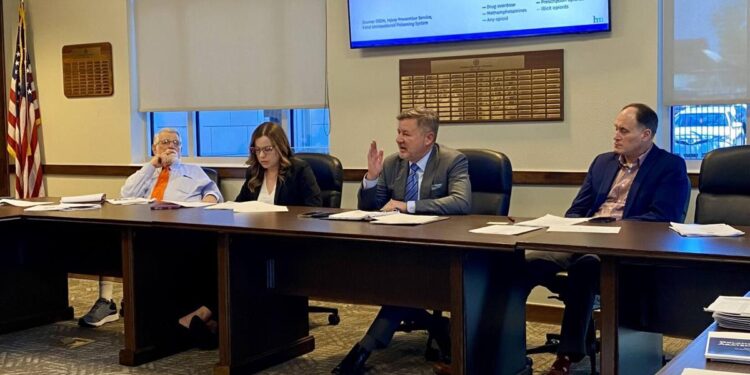Money from legal settlements against opioid manufacturers, distributors and retailers will finally start to trickle out to Oklahoma cities and counties in 2024, almost four years after lawmakers set up a board to administer the funds.
More than 250 local governments told the Oklahoma Opioid Abatement Board they were interested in applying for the grants. The money is supposed to go toward treatment and recovery programs and opioid abuse education and prevention.
The Opioid Abatement Board has about $27 million available for local communities, school districts and public trusts. The Legislature controls another $37.6 million sitting in the Opioid Lawsuit Settlement Fund. Additional funds are expected in coming years since some settlements call for multi-year payouts.
Attorney General Gentner Drummond, who chairs the nine-member board, said he’s been frustrated with the lack of action in getting money to local communities. Board turnover has also been a problem, with at least five members resigning at various times in the past year alone.
“I’ve been a large critic of the management of these funds from previous AGs, and there’s just absolutely no excuse,” Drummond said in an interview. “I’m glad that I have disciplined professionals that slow me down because I would like this money deployed immediately, but we need to be careful with these public funds and we need to be impactful.”
More than 1,700 Oklahomans died as a result of prescription opioid overdose from 2016 to 2021, according to the Oklahoma Board of Narcotics and Dangerous Drugs. Prescription opioid overdose deaths accounted for 33% of all drug overdose deaths during that same period.
States, tribes, cities, and counties pursued the lawsuits to compensate for the large sums of money spent addressing the opioid crisis in health care and law enforcement. Most of the settlements stemmed from multistate actions.
As he campaigned for attorney general in both 2018 and 2022, Drummond criticized his predecessors for the large attorney fees awarded to outside counsel in the state’s lawsuits against opioid-related companies. More than $123 million went to private attorneys across various settlements. Almost half of those fees came from the state’s $270 million settlement with Purdue Pharma. Purdue later filed for bankruptcy reorganization, but that didn’t affect Oklahoma’s settlement with the company.
“I’m very frustrated with the liberality of friends and families of previous AGs,” Drummond said. “We have enriched people that we shouldn’t have, in excess of $100 million. That’s way more than should have been awarded.”
The state is expected to have $308 million in settlement funds from lawsuits related to three distributors – McKesson, AmerisourceBergen Corp. and Cardinal Health – accused of flooding the market with opioid painkillers. The state gets 75% of that money, with the remaining 25% allocated to cities and counties.
Jessica Hawkins, director of community and systems initiatives with Tulsa-based Healthy Minds Policy Initiative, told abatement board members Oklahoma is in the fourth wave of opioid addiction. Prescription opioids marked the first wave, which was followed by heroin, fentanyl and now methamphetamine. Many times, those illicit drugs are being combined with prescription opioids.
“We have a tremendous amount of co-use happening in Oklahoma, with concurrent use of opioids with stimulants, mainly methamphetamine,” Hawkins said at a Dec. 6 board meeting. “This is a nuance that we want communities to understand and the abatement board to hear and think about.”
Hawkins said the board should give local communities adequate time to develop their abatement plans under grant funding. She urged a “go slow to go fast” strategy that would put most of the work in the next few months for the first round of grant awards by summer 2024.
“You’ll want to make sure they are selecting evidence-based strategies,” Hawkins said. “In the field of behavioral health and mental health, we do not need to burden local communities that they need to develop their own programs or come up with their own ideas. There are a plethora of best practices that are available out there for the choosing as long as you know what your community’s problems are that need to be abated.”
Board members discussed hiring Healthy Minds to help with the grant application process and provide educational outreach to local governments. The attorney general’s office, which provides administrative support for the board, is interviewing candidates for a grant coordinator position.
Drummond said his office is working with lawmakers to earmark a percentage of settlement funds for the abatement board as it considers grant applications from local governments in the coming years.
Settlement frustrations
Oklahoma lawmakers set up the opioid abatement board in 2020 and seeded it with a $10.22 million appropriation. They set up the board after being frustrated over settlement terms with Purdue negotiated in 2019 by former Attorney General Mike Hunter. Many lawmakers thought they should have had a say in how the Purdue settlement money was distributed.
Just 5% of the Purdue settlement will go to local governments for opioid abatement. Most of it went to Oklahoma State University’s National Center for Wellness and Recovery, which was established in 2017. The center received $102.5 million from the Purdue settlement in a lump sum. Another $75 million is being paid over three years, and it got $20 million in the form of buprenorphine and naloxone, known under the brand name Suboxone. The medication is used to treat opioid-use disorder or withdrawal symptoms.
Neile Jones, communications manager for the National Center for Wellness and Recovery, said the center is tackling the drug crisis through research, outreach and treatment. Its Addiction and Recovery Clinic in Tulsa helps families and individuals fighting addiction.
“We have begun design and construction on important research facilities in Tulsa,” Jones said in an email. “We have recruited a team of highly skilled neurobiologists, chemists and Ph.D. students to advance our research efforts and anticipate continued growth. Our collaboration with the University of Arizona includes several vital research projects, including stronger treatments to reverse fentanyl overdose.”
The distributor and Purdue settlements are just parts of the almost $700 million in settlements Oklahoma reached from opioid-related litigation. Others include:
Teva Pharmaceuticals: $85 million
McKinsey & Co.: $8.9 million
Endo Pharmaceuticals: $8.75 million
Mallinckrodt: $5.1 million
Missing from those totals is the $465 million judgment against Johnson & Johnson that Hunter and outside attorneys won at trial in 2019. The Oklahoma Supreme Court overturned that on appeal in November 2021.
Nationwide, more than $52 billion will be paid to states over the next 18 years from settlements with opioid manufacturers, distributors and retailers.
Oklahoma Watch, at oklahomawatch.org, is a nonprofit, nonpartisan news organization that covers public-policy issues facing the state.
Want to reach a local audience and grow your business?
Our website is the perfect platform to connect with engaged readers in your local area.
Whether you're looking for banner ads, sponsored content, or custom promotions, we can tailor a package to meet your needs.
Contact us today to learn more about advertising opportunities!
CONTACT US NOW






